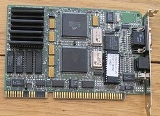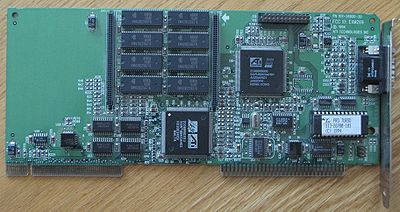
ATI Mach
Encyclopedia
The ATi Mach line was a series of 2D graphics accelerators
for personal computer
s developed by ATI Technologies
. It became an extension (and eventual successor) to the ATI Wonder series
of cards. The first chip in the series was the ATi Mach8. It was essentially a clone of the IBM 8514/A with a few notable extensions such as Crystal fonts. Being one of the first graphics accelerator chips on the market, the Mach8 did not have an integrated VGA core. In order to use the first Mach8 coprocessor cards, a separate VGA card was required. This made ownership considerably expensive. A temporary solution was presented with the ATi Graphics Ultra/Vantage cards, which combined an ATi 8514 Ultra and VGA Wonder+ into a single card (though using discrete ICs). The Mach32 chip was the follow-up to the Mach8, which finally featured an integrated VGA core, true colour support and a 64-bit datapath to internal memory.
 The Mach 8 chip was used on the following ATI products:
The Mach 8 chip was used on the following ATI products:
The Mach 32 chip was used on the following ATI products:
 Released: 1994
Released: 1994
The Mach 64 chip was used on the following ATI products:
Mach64 GX Family:
Mach64 CT Family:
Mach64 VT Family:
Mach64 GT Family:
Mach64 GT-B Family:
Important Note: The 3D Rage and 3D Rage II chips were also known as Mach64 GT and Mach64 GT-B respectively. The Mach64 moniker was eliminated with introduction of the 3D Rage Pro.
2D computer graphics
2D computer graphics is the computer-based generation of digital images—mostly from two-dimensional models and by techniques specific to them...
for personal computer
Personal computer
A personal computer is any general-purpose computer whose size, capabilities, and original sales price make it useful for individuals, and which is intended to be operated directly by an end-user with no intervening computer operator...
s developed by ATI Technologies
ATI Technologies
ATI Technologies Inc. was a semiconductor technology corporation based in Markham, Ontario, Canada, that specialized in the development of graphics processing units and chipsets. Founded in 1985 as Array Technologies Inc., the company was listed publicly in 1993 and was acquired by Advanced Micro...
. It became an extension (and eventual successor) to the ATI Wonder series
ATI Wonder series
The ATi Wonder series represents some of the first graphics add on products for IBM PCs and compatibles introduced by ATi Technologies in the mid to late 1980s. These cards were unique at the time as they offered the end user a considerable amount of value by combining support for multiple graphics...
of cards. The first chip in the series was the ATi Mach8. It was essentially a clone of the IBM 8514/A with a few notable extensions such as Crystal fonts. Being one of the first graphics accelerator chips on the market, the Mach8 did not have an integrated VGA core. In order to use the first Mach8 coprocessor cards, a separate VGA card was required. This made ownership considerably expensive. A temporary solution was presented with the ATi Graphics Ultra/Vantage cards, which combined an ATi 8514 Ultra and VGA Wonder+ into a single card (though using discrete ICs). The Mach32 chip was the follow-up to the Mach8, which finally featured an integrated VGA core, true colour support and a 64-bit datapath to internal memory.
Mach 8
Released: 1991- IBM 8514/A clone
- Support for up to 8-bit colour modes
- Optional VGAWonder 2 (28800) graphics core (with dedicated 256–512 kb DRAM)
- 512 KB or 1 MB available with either DRAM or VRAM
- Port: ISA, MCA

- 8514 Ultra (VRAM, coprocessor only)
- 8514 Vantage (DRAM, coprocessor only)
- Graphics Vantage (DRAM)
- Graphics Ultra (VRAM)
- VGAWonder GT (Repackaged Graphics Ultra, 1 MB RAM standard)
Mach 32
Released: 1992- 32-bit32-bitThe range of integer values that can be stored in 32 bits is 0 through 4,294,967,295. Hence, a processor with 32-bit memory addresses can directly access 4 GB of byte-addressable memory....
GUIGraphical user interfaceIn computing, a graphical user interface is a type of user interface that allows users to interact with electronic devices with images rather than text commands. GUIs can be used in computers, hand-held devices such as MP3 players, portable media players or gaming devices, household appliances and...
accelerator2D computer graphics2D computer graphics is the computer-based generation of digital images—mostly from two-dimensional models and by techniques specific to them...
with basic DOSDOSDOS, short for "Disk Operating System", is an acronym for several closely related operating systems that dominated the IBM PC compatible market between 1981 and 1995, or until about 2000 if one includes the partially DOS-based Microsoft Windows versions 95, 98, and Millennium Edition.Related...
support - Limited VESA VBEVESA BIOS ExtensionsVESA BIOS Extensions is a VESA standard, currently at version 3, that defines the interface that can be used by software to access compliant video boards at high resolutions and bit depths...
support - Support for 15 bbp, 16 bbp and 24 bbp colour modes added
- Video memory: 1 or 2 MiBMIBMIB may refer to any of several concepts:* Master of International Business, a postgraduate business degree* Melayu Islam Beraja, the adopted national philosophy of Brunei* Motion induced blindness, a visual illusion in peripheral vision...
DRAMDynamic random access memoryDynamic random-access memory is a type of random-access memory that stores each bit of data in a separate capacitor within an integrated circuit. The capacitor can be either charged or discharged; these two states are taken to represent the two values of a bit, conventionally called 0 and 1...
or VRAM - Memory interface: 64-bit64-bit64-bit is a word size that defines certain classes of computer architecture, buses, memory and CPUs, and by extension the software that runs on them. 64-bit CPUs have existed in supercomputers since the 1970s and in RISC-based workstations and servers since the early 1990s...
- Port: ISAIndustry Standard ArchitectureIndustry Standard Architecture is a computer bus standard for IBM PC compatible computers introduced with the IBM Personal Computer to support its Intel 8088 microprocessor's 8-bit external data bus and extended to 16 bits for the IBM Personal Computer/AT's Intel 80286 processor...
, EISAExtended Industry Standard ArchitectureThe Extended Industry Standard Architecture is a bus standard for IBM PC compatible computers...
, VLBVESA Local BusThe VESA Local Bus was mostly used in personal computers. VESA Local Bus worked alongside the ISA bus; it acted as a high-speed conduit for memory-mapped I/O and DMA, while the ISA bus handled interrupts and port-mapped I/O.-Historical overview:In the early 1990s, the I/O bandwidth of...
, PCIPeripheral Component InterconnectConventional PCI is a computer bus for attaching hardware devices in a computer...
, MCAMicro Channel architectureMicro Channel Architecture was a proprietary 16- or 32-bit parallel computer bus introduced by IBM in 1987 which was used on PS/2 and other computers through the mid 1990s.- Background :... - Integrated VGA core
- 100% compatible with IBM 8514/A
The Mach 32 chip was used on the following ATI products:
- Graphics Wonder (DRAM)
- Graphics Ultra + (DRAM, fast RAMDAC)
- Graphics Ultra CLX (DRAM, cost-reduced OEM version)
- Graphics Ultra Pro (VRAM)
- Graphics Ultra XLR (VRAM, cost-reduced OEM version)
Mach 64

- 64-bit GUI accelerator with basic DOS support
- Limited VESA VBE support
- Video memory: 1, 2, 4 or 8 MiB DRAM, VRAM, or SGRAM
- Memory interface: 64-bit
- Port: ISA, VLB, PCI
- Variants:
-
- "Mach64 CX/210888" - Original chipset, uncommon (up to 2 MB DRAM, or 4 MB VRAM)
- "Mach64 GX/210888GX" - Enhanced video playback capabilities
- "Mach64 ET/210888ET" - Embedded???
- "Mach64 CT/264CT - Cost-reduced Mach64 with integrated RAMDAC and clock chip (up to 2 MB DRAM)
- "Mach64 VT/264VT - AMC connector (Support for TV-tuner)
- "Mach64 GT/264GT 3D RageATI RageThe ATI Rage is a series of graphics chipsets offering GUI 2D acceleration, video acceleration, and 3D acceleration. It is the successor to the Mach series of 2D accelerators.-3D RAGE :...
" - 3D capabilities - "Mach64 GT-B/264GT-B 3D Rage II - SDRAM & SGRAM support(up to 8 MB)
- "Mach64 LT/264LT" - Low-power mobile version of Mach64 GT
The Mach 64 chip was used on the following ATI products:
Mach64 GX Family:
- Graphics Xpression (1 or 2 MB DRAM)
- Graphics Pro Turbo (2 or 4 MB VRAM)
- WinTurbo (1 or 2 MB VRAM, non-upgradable)
- Graphics Pro Turbo 1600 (fast RAMDAC,PCI-only)
- XCLAIM GA (Macintosh)
Mach64 CT Family:
- WinBoost (1 MB DRAM, upgradable to 2mb)
- WinCharger (2 MB DRAM)
Mach64 VT Family:
- Video Charger
- Video Xpression (Mach64 VT2)
- Video Xpression+ (Mach64 VT4)
Mach64 GT Family:
- 3D Xpression (2 MB EDO DRAM))
Mach64 GT-B Family:
- 3D Charger (2 MB EDO DRAM)
- 3D XPRESSION+ (2 or 4 MB SDRAM)
- 3D XPRESSION+ PC2TV (TV-out)
- 3D Pro Turbo (2, 4, 6 or 8 MB SGRAM)
- 3D Pro Turbo+ PC2TV (TV-out)
- Xclaim VR - early versions (Macintosh, 2, 4 or 8 MB SGRAM, Video-In Video-Out)
- Xclaim 3D - early versions (Macintosh, 4 or 8 MB SGRAM)
- All-In-Wonder (SDRAM, TV Tuner)
Important Note: The 3D Rage and 3D Rage II chips were also known as Mach64 GT and Mach64 GT-B respectively. The Mach64 moniker was eliminated with introduction of the 3D Rage Pro.

